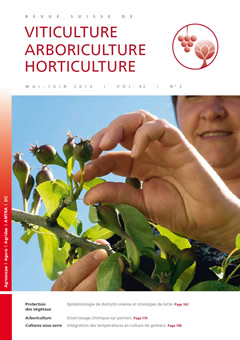
Issue 3 - May - June 2010
Abstract in open access
Crop load regulation is often necessary in order to achieve an optimal pear quality and regular production. This regulation is performed manually leading to supplementary costs that limit economical productivity of pear crops. The aim of this study was to assess the phytotoxicity and the efficiency of chemical thinner on four pear cultivars. Depending on the thinner, the application exhibited large differences in the efficiency on Louise Bonne, Harrow Sweet, Beurré Bosc and Conference, leading sometimes to an excessive thinning and consequently to a lower yield. Higher fruit size was rarely observed for Louise Bonne, Harrow Sweet and Beurré Bosc. On the contrary, for Conference, higher fruit size resulted always from a lower crop load. A foliar phytotoxicity was observed with naphthaleneacetamide (NAAm) and a high proportion of pygmies fruits was produced with naphthaleneacetic acid (NAA) applications. The results of this study show that chemical thinning is not appropriate for Louise Bonne, Harrow Sweet and Beurré Bosc. On the contrary, benzyladenine (BA) application seems to be promising for Conference.
Keywords: biennial bearing, chemical thinning, pears
E-Mail: danilo.christen@acw.admin.ch
Adress:
Abstract in open access
Apple texture, particularly firmness, figures among the main attributes of fruit quality in commercial transactions. The reference method for controlling apple firmness is penetrometry (destructive and punctual measure). The development of new technologies and new methods for signal analysis should permit to progress in domain of nondestructive measurement of fruit quality. The acoustic measurements seem very promising for this purpose. The work presented in this article shows that frequencies from the fruit response to the acoustic solicitation are repeatable. Moreover the method could be sensitive enough to discriminate the blushed from unblushed fruit face.
Keywords: acoustic measurement, texture, apple
E-Mail: p.vandewalle@groupe-esa.com
Adress: Ecole supérieure d'agriculture d'Angers ESA, F-49007 Angers Cedex 01
Abstract in open access
Since the appearance of the quarantine disease flavescence dorée, Swiss winegrowers' general awareness for the bois noir disease has considerably increased. Both grapevine yellows diseases elicit identical symptoms and are transmitted by insects. Hyalesthes obsoletus Signoret (Hemiptera, Cixiidae) is assumed to be the principal vector of bois noir in Europe. Its nymphs normally develop on the roots of field bindweed or stinging nettle. Grapevine appears to be only an erroneous food source for H. obsoletus adults. In Switzerland, the epidemiology of bois noir disease is at present poorly understood and the interaction between the phytoplasma, the insect vector, the original host plants and grapevines is unknown. In a first step, we studied the distribution and biology of the vector. A national survey revealed that H. obsoletus is present in most viticultural areas of Switzerland, mainly on stinging nettle. Adult planthoppers were captured from June to September 2008 and they were most abundant in July. The vector is quite mobile and capable of flying over several dozen meters. In conclusion, H. obsoletus and U. dioica seem to play central roles in the epidemiology of bois noir in Swiss vineyards.
Keywords: Viticulture, Vitis vinifera, phytoplasma, stolbur, plant-vector associations
E-Mail: patrik.kehrli@acw.admin.ch
Adress:
Abstract in open access
Modifying the climatic steering by using temperature integration (IT) over 24 hours is one of the ways of realising energy saving in greenhouse crops. A trial conducted from 2007 to 2009 in soilless gerbera crop showed that about 15 % energy saving for the whole crop was possible. The yield in number of stems per square metre, the stems development rate as well as the vase life duration were not influenced by the IT steering. However, the stems were slightly shorter with IT. Regarding the phytosanitary aspects, the IT had no effect on the development of predatory mites (Typhlodromips swirskii, Amblyseius cucumeris) nor on this of powdery mildew. There was less whitefly pressure in the IT greenhouse. The results confirm that temperature integration is a useful method to save energy in soilless gerbera crop without yield and quality losses.
Keywords: energy saving, yield, vase life, quality
E-Mail: celine.gilli@acw.admin.ch
Adress:
Abstract in open access
Oregano essential oil is rich in carvacrol and is recently the subject of a great interest for its use in the production of feed additives, mainly for his antimicrobial properties. The French region of Franche-Comté launched a project to determine the economic potential of this new culture. Three commercial varieties of oregano, Carva, Origalia and Bolier were evaluated on three sites with very different soil and climate conditions in the departments of Jura and Haute-Saône, from 2004 to 2006. This lamiacea revealed very well suited to relatively hard climatic conditions in this region. Cultivars Carva and Origalia proved to be the richest in essential oil (7.5 %). They are also better suited to the altitude sites. The good strength of Carva is even an advantage in the 1st year of harvest, with higher average yields. With a potential production within two years of 400 l/ha of essential oil with a carvacrol content of 75-80 %, oregano culture can be considered as a valuable source of natural carvacrol for the industry.
Keywords: Origanum, essential oil, carvacrol
E-Mail: xavier.simonnet@acw.admin.ch
Adress: Médiplant, 1964 Conthey

 Download of full issue
Download of full issue
 Download article
Download article